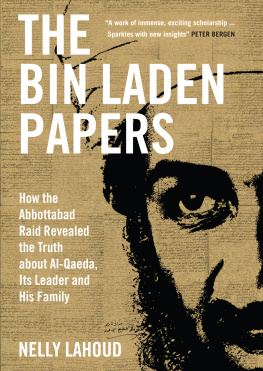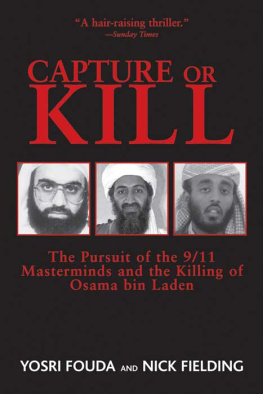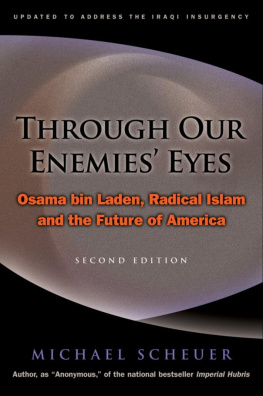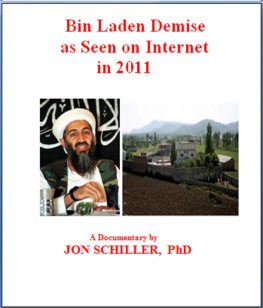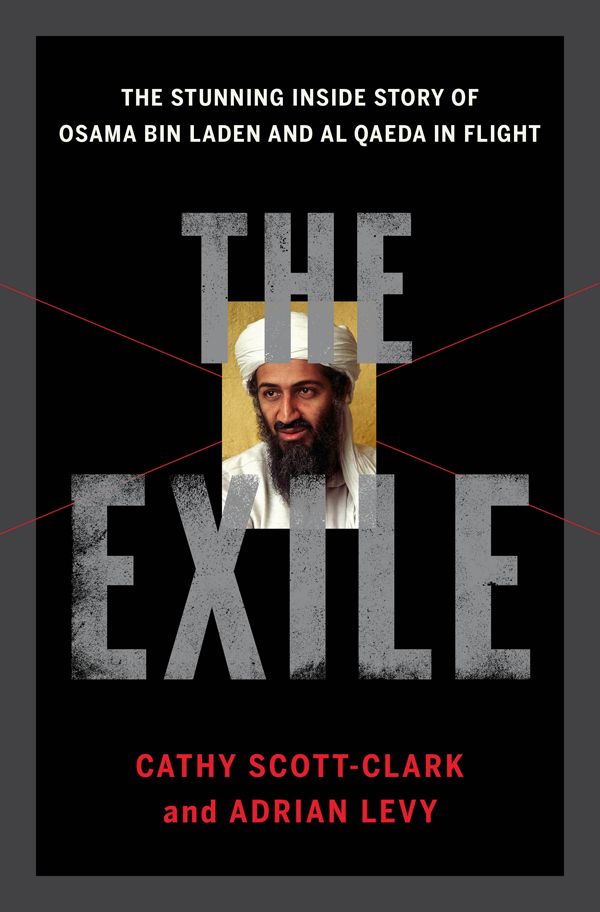Contents
Guide
Pagebreaks of the print version
More Praise for The Exile
Where did Osama bin Laden, his family, and Al Qaeda disappear to for a decade after 9/11 and Tora Bora? In The Exile , Cathy Scott-Clark and Adrian Levy reveal a staggering amount of fresh information as to how Osama bin Laden survived and give us a picture of the missing years. This is a remarkable book that readers will not be able to put down.
Ahmed Rashid, author of Taliban , Descent into Chaos , and Pakistan on the Brink
The West spends far too little time trying to understand those who attacked on 9/11, and if we do not understand them, we will never combat their ideology. The Exile fills the gap in a very thorough and readable way.
Clive Stafford Smith, director of Reprieve and legal representative of more than one hundred Guantnamo detainees
The Exile combines a reporters meticulous research with the skill of a thriller writer. This is a must-read for those interested in understanding the dynamics of global jihad.
Husain Haqqani, former Pakistan ambassador to the United States and author of Magnificent Delusions: Pakistan, the United States, and an Epic History of Misunderstanding
A fascinating, dynamic, and detailed accountbased on considerable researchof how the ideas and people of Al Qaeda survived and revived after 9/11. Informative and highly readable.
Richard Barrett, former head of counterterrorism for MI5 and MI6
The Exile
For GG
BY THE SAME AUTHORS
The Stone of Heaven: Unearthing the Secret History of Imperial Green Jade
Nuclear Deception: The Dangerous Relationship between the United States and Pakistan
The Meadow: Kashmir 1995Where the Terror Began
The Amber Room: The Fate of the Worlds Greatest Lost Treasure
The Siege: 68 Hours inside the Taj Hotel

Contents
Shit. I think we bit off more than we could chew.
Terrorism is a duty and assassination is a Sunnah .
These Arabs they have killed Afghans. They have trained their guns on Afghan lives We want them out.
Poor ones, this is not how revenge is, or will be.
The banging was so strong that I felt at some point that my skull was in pieces.
If you bid us plunge into the ocean, we would follow you.
The reprisals of the mujahideen shall come like lightning bolts.
We will get you, CIA team, inshallah , we will bring you down.
Im back with the people I was with before.
We go to a house, we fuck with some people, and we leave. This is just a longer flight.
What really happened doesnt matter if there is an official story behind it that 99.999% of the world would believe.
It is going to be worse when my father dies. The world is going to be very, very nasty it will be a disaster.
It will be just the end of the beginning rather than the beginning of the end.

Eighteen years into an epoch of Islamist terror that began with horrific attacks on U.S. embassies in East Africa in 1998, few books have told the story of Al Qaeda from the inside.
Part of this is due to difficulty. Getting into any volatile, paranoiac outfit, one that executes outsiders as spies or lures reporters to meetings that become kidnappingsis hair-raising. Instead, we have had gripping tales of those in the West and the Gulf states who have hunted Al Qaeda. The prism through which we see this bloody era has become a police proceduralpathological killers triangulated by deep-in-the-weeds analysts using sources procured by intelligence officers out in the field, parrying with American special agents for interrogation rights.
However, there is another reason why apart from the great volumes that chart the road to 9/11 there has been no history of these times told by the other side, and that is an extraordinary act of control by Western governments. To find an equivalent, one would have to go all the way back to the 1980s and the actions of the British government in its dealings with the Irish Republican Army, when jury trials were suspended, Catholics were interned, and the voice of Sinn Fin leader Gerry Adams was banned on TV and replaced with that of an actor (while secretly Prime Minister Margaret Thatchers emissary negotiated with the IRA).
After 9/11, the Bush administration incarcerated, en masse, as many as 779 suspected enemy combatants in Guantnamo military prison in Cuba. Even now that the number has been whittled down to 41 at the time of press, the prison still costs half a billion dollars a year to run. Only five men accused of being directly involved in the planning or execution of 9/11 have been put on trial, and their hearings drag on at a snails pace.
In August 2016, Abu Zubaydah, who the Bush administration claimed was Number Three in Al Qaeda but who the Obama administration concluded had never been a formal member of the outfit, appeared before a Guantnamo review board, the first time he had been seen publicly in almost fifteen years. He had been rendered to Thailand in 2002; waterboarded eighty-three times; confined in a coffin-shaped box and a smaller one resembling a dog kennel; kept awake for days, frozen, naked, shackled, and beaten; and spirited away to several more CIA black sites before landing in Guantnamo in 2006. Even now, observers of the review board hearing were not allowed to listen to his voice. Instead, a Pentagon-appointed personal representativeGitmo-speak for a uniformed U.S. soldierread out his words.
Of the other prisoners who remain in Cuba, we have heard little or nothing. Meanwhile, on the outside, Al Qaeda leaders are mostly dead, in hiding, or compelled to be silent by the Arab, Asian, and African governments that took them in.
What we do have, courtesy of the U.S. government, is a cherry-picked history. In 2012, a sample of Al Qaedas letters and communiqus was released to academics from the Combating Terrorism Center at the U.S. Military Academy at West Point. They were previewed in a powerful Washington Post opinion piece by David Ignatius, Osama bin Laden, a Lion in Winter, and suggested that fractious Al Qaeda was as finished as its newly dead emir. Also put into the public domain were well-chosen images showing Osama, graying and diminished, watching his TV set or fudging his words in outtakes from videoed speeches. Unnamed Defense officials claimed that he had become delusional and impotent, and that his organization was defunct. To further undercut Al Qaedas well-crafted image of a pious Sheikh who saw himself as a ghazi , or holy warrior, rumors were started about his alleged pornography collection.
The same year, the Obama administration backed Zero Dark Thirty an overt wedding of the White House to Hollywood, where the CIA, Pentagon, and West Wing facilitated a thrilling cinematic account of the sleuthing that led to the raid on Abbottabad. The impact of the photographs, documents, and this film was to suggest that a president, Obama, canvassing for his second term in the White House, had beaten an old enemy, Al Qaeda, that was so pathological that U.S. interrogators had been required to deploy pitiless means to crack it. The killing of Osama bin Laden was a major factor in Obamas reelection.
But Zero Dark Thirty , nominated for five Academy Awards, was materially wrong in many ways, perhaps none more important than its claim that torture unearthed vital knowledge leading to Osamas capture. In truth, the real trail had been pieced together through dogged detective work, good luck, and well-crafted interrogations conducted well before the beatings and mock executions.


